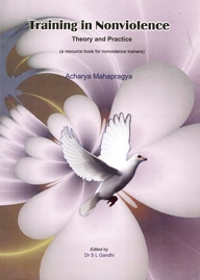Two persons were going somewhere. They came upon a river on the way. It was overflowing with water. One of them remained standing on the bank while the other jumped into the water, swam and reached the other bank. Why does it so happen? Crossing a river is a problem. One of the persons couldn’t solve this problem while the other could and was able to cross the river and reach the other bank. It reveals that the problem was not very difficult. One who knew how to swim was able to reach the other bank. One who didn’t know swimming remained standing on this side of the river. The question that comes to the fore is that of training.
Many problems crop up in our life. Sometimes they are more difficult than the crossing of a river. It is easy to cross a river but to solve the problems that beset our life is extremely difficult. Only a trained person will be able to find a way out of them. He whose heart and mind are not transformed remains stuck at the bank of the river. He cannot cross the river. Training plays an important role in man’s life. An untrained person may not be able to accomplish a task, which a trained person can do in no time. Nothing is possible without training - be they acting, performing arts, professions and jobs. Without it even threading a needle becomes difficult. Everyone cannot thread a needle. In the absence of training even a small thing may create a problem. If a person who doesn’t know how to cook is entrusted with the responsibility of cooking it is certain that he will spoil the meal.
Not only men but also elephants, horses, monkeys and dogs are trained for specific purposes. When a man watches their feats he is astonished. There is no denying the fact that training has become indispensable in all walks of human life. If someone turns a religious person but doesn’t undergo training, it is a matter of great surprise. Just as a person has a right to become a minister without training, similarly it appears that one has a right to be a religious person without any training. An untrained religious person neither does good to dharma nor to himself.
We are having a discussion on a change of heart but how will the human heart change without training? It needs a very rigorous training. In the absence of this training it is impossible to transform a human heart. It is not possible for ahimsa to succeed in life without training. A person said, “When a war breaks out it is futile to think that ahimsa can save us. What will a nonviolent person do in times of war?” I said, “A nonviolent person never fails nor does ahimsa. What fails is actually the absence of effort. When did we impart training in ahimsa? The truth is that so far we have made no effort in this direction. If someone undergoes training in ahimsa, he develops the power to do something. He never fails whose consciousness of dying is awakened and fear of death disappears at a level of war or at any level of conflict in life. The root cause of failure is one’s attachment to life and fear of death. An individual who clings to life and is afraid to die is always unsuccessful. In war such individuals always fail. Only that individual who has overcome attachment to life and has conquered the terror of death can become nonviolent (ahimsak) and such nonviolent person can never fail.
Does a soldier who goes to war carry with him a guarantee of life? When he goes, it is abundantly clear in his mind that death is most probable but if he escapes death, it will be a great thing. He is always conscious of the fact that he may die at anytime. If he remains alive, it is his luck. Why does it happen so? Why does he fight? He who fights with the weapons of mass destruction does so because he has been trained in that art of warfare. The process of training continues from the day he joins the army till the entire span of his life. Every day practice and lessons in theory go on continuously. Nonviolent persons can also fight a war with a sense of utmost fearlessness if they could receive training in nonviolence just half of the training imparted in violence. But today there is neither a provision of training for ahimsa, nor are nonviolent persons being trained for that matter. They believe that ahimsa is their birthright. Since violence is imposed on society, training becomes imperative only in that case. It is a fallacy that ahimsa doesn’t require any kind of training. In the absence of training truth is not succeeding, celibacy and nonpossessiveness are proving to be ineffective. It can be said that all the truths of life, realities of life are coming to nothing because no efforts are being made for imparting training in those values. There are three constituent components of training:
- Inculcation of faith
- Knowledge of the means or ways
- Practice
 Acharya Mahaprajna
Acharya Mahaprajna

